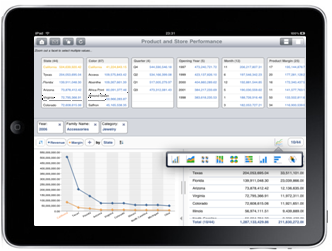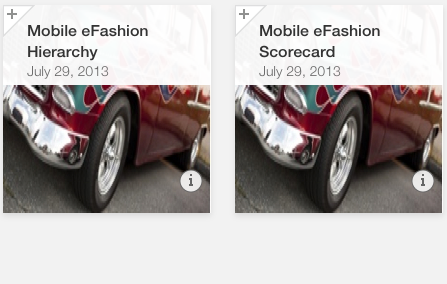Today was an interesting day for mobile BI news. First, Walt Mossberg, David Pogue, and other high-profile journalists released unfavorable reviews of the HP Touchpad. The Touchpad is HP’s first webOS tablet, the operating system inherited as part of their Palm acquisition. Second, ASUG and SAP produced a webcast entitled SAP BusinessObjects Explorer Changes Coming for iPad, iPhone/Mobile in General.

In an interview, HP’s Richard Kerris said that HP is aiming for the enterprise, not Apple. However, like any good enterprise software vendor, SAP is pursuing Apple iOS first because it is leading the market. The HP Touchpad, Blackberry PlayBook, and various Android tablets like the Motorola Xoom and Samsung Galaxy Tab 10.1 all show signs of promise, but none have been declared better than Apple’s iPad. Although my Xcelsius Guru fans are keen on seeing their dashboards on a tablet that supports Adobe Flash, the mobile Flash player remains in beta and flaky.
Regarding SAP BusinessObjects Explorer, version 4.02 is available today for the Apple iPod Touch, iPhone, and iPad. It will be available “Q4” for Android and “early next year” for the Blackberry Playbook. Next year, we’ll see BI 4.1 Feature Pack 3 and Exploration Views, taking Explorer to the next level. Although today’s webcast did not address SAP BI Mobile for the iPad (click here to download BI Mobile from the iTunes App Store), clearly SAP has prioritized Apple iOS development above other mobile platforms. And they’re not alone. Honestly, I’m surprised that HP isn’t writing checks Microsoft-style to convince vendors like SAP to move apps like Explorer to webOS regardless of its market share. Speaking of Microsoft, it is conspicuously absent from this year’s horse race with Apple. It seems that we’ll have to wait until next year’s Windows 8 (see related article, First Impressions of Microsoft Windows 8) to see what a true Microsoft tablet looks like.
Disclaimer: I am a bit of an Apple fan boy. I bought a third-generation black-and-white iPod in 2005, matching husband-and-wife iPhones in 2008, a Mac Mini (my first Mac) in 2010, and an Apple iPad 2 on its release day earlier this year. But I think you have to wake up and face reality— Apple is leading both the smartphone and tablet markets. Don’t believe me? Just visit the lonely tablet area at your local Best Buy.
Corporate IT likes its standards. And its double standards. The RIM Blackberry Playbook is frequently cited as a favorite with organizations that have a large installed base of “secure and reliable” Blackberry phones. However, the Playbook uses an entirely different (and untested, despite its solid QNX roots) operating system. Google has only recently released Android 3.0, its first tablet-ready version of Android. Remember, Android is “open” and Google isn’t “evil”. And Adobe Flash? Please! I’m tired of being told that Flash 10.1, I mean Flash 10.2, uh, I mean Flash 10.3 will support mobile devices. It’s still in beta. And it’s still flaky. Anyone concerned about the lack of Adobe Flash on iOS should compare the web edition of SAP BusinessObjects Explorer— which is entirely Adobe Flash— with the iPad edition. The user experience is virtually identical.
And look at Mellmo’s RoamBI. After breaking ground on the Apple iPhone in 2008, Mellmo is only now getting its software on Blackberry and Android devices. With Mellmo, it was never about marketshare. Marketshare would have put RoamBI first on a Blackberry phone. But it just wasn’t technically possible. The Apple iOS SDK made it possible for RoamBI to do business intelligence in a bold new way. And even though the relationship between SAP and Mellmo seems a bit chilly, corporate BI organizations would do well to consider RoamBI right alongside SAP’s BI Mobile and Explorer offerings.
Apple mobile hardware is in its second (iPad) and fourth (iPhone) generations. The mobile operating system, iOS, will soon be on its fifth major release.
The mobile device and mobile BI markets are both in their infancy. Both will certainly look much different a mere 12 months from now. It’s simply too early to choose a corporate standard for mobile devices. Rather than basing a corporate standard on religious preferences, corporate IT should make mature decisions after small pilot deployments of multiple mobile platforms. Today’s tablet market doesn’t look like today’s personal computer market based on Microsoft Windows. Instead, it looks like the early 1980’s Wild West personal computer market. A horse race of Apple, Atari, Commodore, IBM and others eventually thinned out to IBM + Microsoft MS-DOS as the market leader with the Apple Macintosh as a distant second.
Corporate business intelligence leaders and managers need to make sure that they are seated at the table of their organization’s mobility discussions. Organizations wanting to deploy SAP BusinessObjects Business Intelligence on mobile devices today— not next year— need to get over their aversion to Apple products. Choosing an Android or Playbook tablet as a enterprise standard will delay your organization’s ability to embrace mobile business intelligence.
I’m sure we’ll be having a different conversation about mobile BI next summer. But for now, BI managers should run, not walk, to the Apple Store and get a couple of Apple iPads. Get 3G models, even if your pilot will be Wi-Fi only, as they’ll demo in more places. Deploy a test environment of SAP BusinessObjects BI Mobile, either on your existing XI 3.1 or as part of your BI 4.0 pilot. Show your executives BI Mobile, Explorer, and RoamBI on the iPad with their data. Don’t focus on the device or its vendor.
Focus on the business value and speed that mobile BI can provide to your organization’s fact-based decisions.
What’s your organization’s strategy for mobile business intelligence? Join the conversation below.

Great article. Apple have really set the standard in as far as tablets UI. Couple that with the amazing depth of the app store and they will lead the both the consumer and enterprise market (“consumerization of enterprise IT”) for some time.